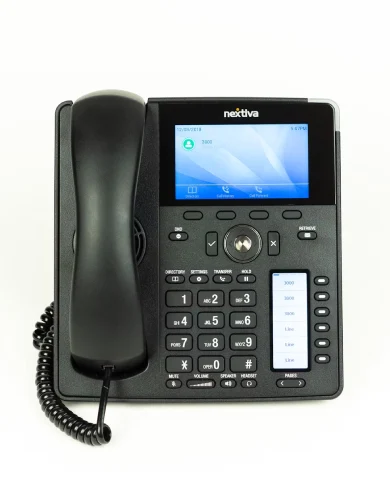Leased line speeds
Choosing the right leased line speed is essential for keeping your business connectivity future-proof and fit for purpose.
While over a dozen speed options are available, most fall into four core tiers, based on your line’s installed capacity: 100 Mbps, 1 Gbps, 10 Gbps, or higher.
This guide explains each speed tier, what use cases it supports, and how to test and monitor the speeds you’re paying for.
Contents:
- The importance of leased line speeds
- Leased line speed tiers
- How to choose the right leased line speed
- How to test and monitor leased line speed
The importance of leased line speeds
Businesses typically require more reliable and higher-quality bandwidth (the same as speed) than residential broadband users, which is exactly what leased lines are designed to deliver.
Compared to standard business broadband, all leased lines provide:
- Uncontended speeds: Your bandwidth isn’t shared with other users, so performance remains consistent.
- Symmetrical speeds: Upload and download rates are equal, which is essential for collaborative work, video conferencing, and VoIP.
- Fibre optics speeds: Delivering high speed together with low latency, high reliability, and strong performance even under heavy use.
But while these are standard characteristics, business broadband providers offer various leased line speed commitments and bearer capacities to choose from.
The higher the circuit speed committed (i.e., your delivered bandwidth), the more users, services, and applications your connection can support simultaneously, from routine day-to-day operations to real-time solutions like business VoIP phone systems.
Meanwhile, a higher bearer capacity (such as 1+ Gbps) enables quick scalability in case your business grows faster than expected or experiences a sudden spike in demand.
Although other performance factors like latency and Quality of Service (QoS) policies influence performance, speed (also known as throughput or bandwidth) remains the foundation.
This is because in broadband, throughput is like lanes on a motorway. The more lanes, the more traffic the motorway can handle, regardless of other factors like speed limits or toll booths.
Leased line speed tiers
Leased lines are available in a wide range of specific speeds, from 10 Mbps to over 100 Gbps, designed to meet different business requirements.
While useful in some cases, this level of detail can complicate decisions. For example, the difference between 10 Mbps and 20 Mbps is often marginal.
Instead, it’s more practical to group leased lines by bearer capacity: the maximum speed your physical line can support without hardware changes. This is what determines your upgrade flexibility and future scalability.
Before we look at the tiers, here are two key terms to understand:
- Bearer capacity: The top speed your line can physically support, based on installed hardware.
- Circuit speed (CIR): The actual speed configured by your provider. This can be increased, up to the bearer limit, without needing new equipment.
The main bearer classes are:
- 100 Mbps bearer (Entry-level)
- 1 Gbps bearer (Mid-tier)
- 10 Gbps bearer (High-end)
- Carrier-grade speeds (>10 Gbps)
Here’s how each one works in practice:
Entry-level speeds (<100 Mbps)
Best for: SMEs (<10 people), small business VoIP setups, basic cloud apps, remote access
This bearer tier has the lowest cost and is the easiest to deploy due to lower hardware requirements and local contention tolerances, but gives limited headroom for growth or heavier applications.
Key characteristics
- Bearer capacity: 100 Mbps
- Interfaces (LAN cables): 100Base-T (copper) or 100Base-FX (fibre)
- Network equipment: Standard router/network switch with Fast Ethernet (100 Mbps) ports.
- Optical transceivers: Standard 100 Mbps SFPs
- Typical speed options: 10 / 20 / 30 / 50 / 100 Mbps
Mid-tier speeds (100–1,000 Mbps)
Best for: Medium-sized businesses (10–100 users), multi-site VPNs, cloud-heavy workloads, VoIP, hybrid working
This is a flexible option with room to scale, especially in combination with a secondary redundant connection like SoGEA for supporting background processes.
Meets the requirements of most medium-sized businesses, and can be easily adapted into a point-to-point leased line for business Ethernet connectivity.
Key characteristics
- Bearer capacity: 1 Gbps
- Interfaces (LAN cables): 1000Base-T or 1000Base-LX/SX
- Network equipment: Business-grade router/switch/firewall with Gigabit Ethernet ports
- Optical transceivers: Standard 1G SFP modules
- Typical speed options: 100 / 200 / 300 / 500 / 1,000 Mbps
High-end speeds (1–10 Gbps)
Best for: Large enterprises (100+ concurrent users), data centres, universities, real-time processing, backups, service hosting.
This is the fastest commercially available tier, delivering high throughput with very low latency.
It’s ideal for demanding, time-sensitive or large-scale enterprise workloads. It comes with much higher leased line installation costs and power requirements than low and mid-tiers.
Key characteristics
- Bearer capacity: 10 Gbps
- Interfaces (LAN cables): 10GBase-LR or ER
- Network equipment: High-performance routers/switches/firewalls with SFP+ (10G) ports and enterprise-grade throughput
- Optical transceivers: 10G SFP+ modules
- Typical speed options: 1 / 2 / 5 / 10 Gbps
Carrier-grade speeds (>10 Gbps)
Best for: Telecoms carriers, broadband providers, large-scale cloud and hosting platforms (1000+ concurrent users), data centre interconnects, and enterprise backbone infrastructure.
These are ultra-high capacity, custom-engineered connections, suitable only for specialised applications. Can be delivered in three different ways:
- Dedicated wavelength services (e.g. 100 Gbps Optical Ethernet)
- Multiple aggregated 10 Gbps circuits (Link Aggregation)
- Dark fibre
Pricing, availability, and lead times vary based on proximity to your provider’s core network, and is deployed on a bespoke basis with advanced SLAs.
Key characteristics
- Bearer capacity: Technically infinite
- Interfaces (LAN cables): QSFP+ or QSFP28 modules over single-mode fibre using 40G / 100G standards
- Network equipment: 40G/100G-capable switches, routers, or DWDM platforms
- Optical transceivers: 40G QSFP+ or 100G QSFP28 modules
- Typical speed options: 20 / 40 / 100 / 200+ Gbps
How to choose the right leased line speed
Opting for a leased line connection already gives you the most stable, low-latency, and scalable form of business connectivity, but choosing the right speed tier requires careful planning beyond just current usage.
To get the most value and performance, it’s important to consider future growth, upgrade flexibility, and how well your connection can handle short-term traffic bursts or long-term scaling needs.
Here is a step-by-step guide to help you select the right speeds:
1. Assess current usage
Start with a baseline of your current network load:
- Number of users or devices concurrently online
- Application types (e.g. VoIP, video conferencing, cloud sync, UCaaS)
- Business-critical systems that rely on stable, low-latency access
- Upload and download usage patterns and peaks
This gives a working minimum for your bandwidth requirement.
2. Plan for future growth
Consider how your needs might change over the next 36 – 60 months (typical leased line business broadband contract length):
- Expected headcount increases (on-site and remote)
- Greater reliance on cloud platforms or hosted systems
- New or expanding data-heavy workflows (e.g. offsite backups, large media uploads, CAD/modelling, file replication)
- Upgrading bearer capacity usually requires new equipment or re-engineering, which can take several weeks.
- Installing a bearer with extra headroom upfront (e.g. a 1 Gbps bearer even if you only need 200 Mbps initially) allows you to scale up quickly, often within a few business days.
3. Understand burst capability
Providers like Vodafone business broadband offer burstable bandwidth, which allows you to exceed your committed speed temporarily to handle traffic spikes such as:
- Application updates
- Marketing-driven traffic surges (i.e. going viral)
- Short-term data migration or sync events.
These are usually only available on 1 Gbps or 10 Gbps bearers, and are often metered separately (e.g. billed per GB above threshold).
They’re often subject to fair usage policies or provider-side traffic shaping, and are not guaranteed (depends on your provider’s load balancing and available headroom).
4. Check upgrade flexibility
Even if your current usage is below bearer capacity (contact your provider if you’re not sure), make sure you understand your provider’s upgrade process:
- Are bandwidth increases instant, or do they require re-contracting?
- What are the typical lead times for bandwidth changes?
- Are there any costs, SLAs, or downtime risks tied to the upgrade?
Choose a provider with scalable bandwidth policies that align with how quickly your business may need to react to changes in demand.
5. Review SLAs
Service Level Agreements (SLAs) define the contractual performance guarantees from your leased line provider. All leased lines come with SLAs, but not all are equal, and the details matter.
Look for clear guarantees around:
- Bandwidth guarantees: Leased lines are uncontended, meaning the bandwidth is hardcoded for you. If you’re offered 1 Gbps, your provider will guarantee 1 Gbps. There’s no “up to” speed figures or bandwidth throttling.
- Performance under load: Higher speed tiers guarantee better latency, jitter, and packet loss.
- Priority resolution: Faster fault response times and escalation paths are typically available at 1 Gbps and above.
- Monitoring frequency: Mid and high-tier services usually include more frequent or real-time performance monitoring.
If you are using a managed service provider, you will benefit from enhanced SLAs layered on top of the base connectivity:
- Proactive alerts and monitoring
- Faster or more transparent support escalations
- Regular performance reporting and review
How to test and monitor leased line speed
Many businesses get leased lines as part of a managed service, often bundled with additional networking solutions like SD-WAN or MPLS. In these setups, the provider typically takes responsibility for monitoring performance and flagging any issues.
However, if you’re managing the leased line yourself, it’s essential to regularly verify that your connection is delivering the committed speeds and reliability promised under your SLA.
Here’s how to do that effectively:
Using business-grade speed testing tools
Standard broadband speed tests are designed for consumer-grade connections and may not provide accurate or consistent results for leased lines.
They are often affected by browser limitations, background processes, or inconsistent routing to test servers, which may be globally distributed.
Instead, use:
- Provider-supplied testing tools or dashboards.
- Dedicated testing appliances that sit on the network edge (router).
- Enterprise network monitoring platforms for continuous tracking.
- Command-line tools (e.g. iperf, mtr, ping, traceroute) for direct, low-level diagnostics
These tools offer better control over test parameters and visibility into other crucial performance metrics such as latency, packet loss, or routing anomalies.
Key performance metrics to monitor
Speed (i.e. bandwidth or throughput) is only one part of overall performance. To maintain service quality and diagnose issues early, you should monitor at a minimum:
- Download and upload speeds: To confirm you’re getting your committed rate
- Latency (ping): Especially important for real-time apps like remote VoIP and real-time collaboration.
- Jitter: Variations in latency that can affect real time apps.
- Packet loss: Small data losses that can disrupt voice, video, and data transfer.
These metrics should be checked both periodically and during reported issues.

